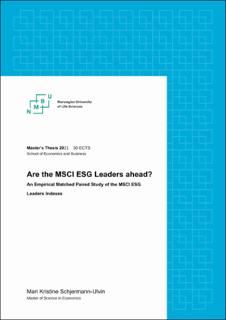| dc.description.abstract | This thesis investigates the comparative financial performance of 62 indexes within the MSCI universe, between the years 2010 and 2019, the subperiod 2016 to 2019 and analyses the investment approach employing the Carhart four-factor model. The main motivation behind this study is to take a closer look at the concern of the Department of Labor, with regards to the employment of non-financial metrics, i.e., employing ESG factors as is an investment method.
Of these 62 indexes, 31 are categorized as MSCI ESG Leaders indexes and 31 are their respective parent indexes. This paper uses a matched pair approach based upon the matching executed by MSCI, leaving all the indexes subject to the same methodology. The financial performance evaluation investigates whether MSCI ESG Leaders indexes have managed to deliver better risk adjusted return than their reference indexes and examines the MSCI ESG Leaders indexes by applying well known performance measures like Sharpe Ratio, Information Ratio and Tracking Error. The Carhart four-factor model is applied to explore whether the MSCI ESG strategy possibly is a factor strategy.
While there does not exist a statistically significant difference in returns for the whole time period, and the same holds true for the subperiod, the MSCI ESG Leaders indexes show better returns. The MSCI ESG Leaders indexes also delivers lower volatility in both time periods. Irrespective of the chosen method, the Jensen Alpha, Sharp Ratio, and Information Ratio, the MSCI ESG Leaders seems to be the slightly more optimal choice. The findings contradict Modern Portfolio Theory, that an investment into the entire market will deliver the lowest returns, thereby providing support of the proponents of the ESG strategy, who claims lower risk is expected.
The Carhart four-factor model reveals that there are some applications of tilting the MSCI ESG indexes within the factor SMB, HML and MOM, however for the majority of the MSCI ESG Leaders indexes no significant factor strategy is revealed. | en_US |

